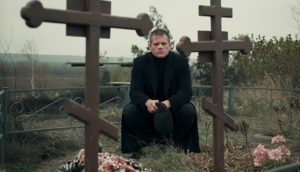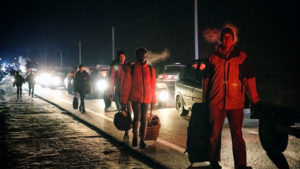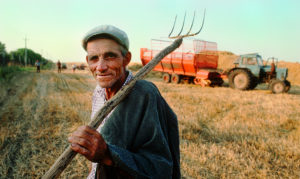On the evening of 24 August last year, Karin Garretsen and her 10-year-old son rode their bicycles to the sprawling army camp on the outskirts of their village in the Dutch countryside. Some Afghans who had fled the Taliban takeover were due to arrive there, and Garretsen’s son wanted to take their children sweets.
Harskamp is the kind of place where everyone knows everyone, a postcard-perfect village of neat houses and tree-lined streets that is home to just over 3,500 people. The idea that the population might increase by 20% overnight came as a shock to some. When the Garretsens neared the Harskamp Barracks, around 250 young local men were burning tyres, hurling fireworks, and howling “Our own people first!” and “Harskamp belongs to us!” Garretsen immediately got her son out of there. “There were fireworks everywhere,” she told me.
Today, on a spring afternoon on the same spot, it is hard to imagine such a scene. The Afghans have left, and the barracks are now home to around 650 people who fled the Russian invasion of Ukraine. On a grassy patch outside the gates, a large Ukrainian flag flies. Refugees cycle past on bikes loaned by locals, giving cheery waves. Volunteers from one of the local churches hand out Dutch syrup waffles to children. A short walk away, Garretsen shows me a clothing bank, brimming with items donated by Harskamp residents.
Harskamp is representative of a wider contradiction in Europe’s treatment of refugees. In 2015 the arrival of more than one million people (most fleeing the Syrian civil war) saw wealthy European nations descend into panic and bickering. Southern nations accused their Northern counterparts of not doing enough to help. While Germany briefly opened its doors to people fleeing war, Eastern European countries rolled out razor wire at their borders, and since then the EU’s refugee policy has focused on keeping people out.
The arrival of more than six million Ukrainians, however, has been met with an outpouring of goodwill and a spirit of cooperation. For the first time, the EU has activated its Temporary Protection Directive, which means Ukrainians arriving in an EU nation have the right to live, work, attend school, and travel freely to any other EU country. There has been very little resistance: even the anti-immigrant populist parties who saw their support surge after the 2015 crisis have been broadly supportive.
The contrast between the warm welcome offered to the largely white, Christian Ukrainians compared to the more hostile reception for people from other cultures and religions has raised valid questions about racism and prejudice. Still, in Harskamp, the new spirit of tolerance appears to extend to everyone. Those I spoke to were embarrassed about the events of eight months ago. “The people here demonstrated and that’s not good,” says 29-year-old Bas Sturm, a deliveryman who organises football games between people living at the barracks and the villagers. They are determined to get it right this time.
While the Afghans have left, about half the people staying in the barracks are non-Ukrainians, who were in the country for reasons such as work or study when Russia invaded. “We were welcomed [in Harskamp] in a way we never thought we would be,” says 20-year-old Algerian Guedah Siefedinne, who was studying business administration in Kyiv. “They didn’t care if we came from Ukraine or not. It was just, ‘you need help: you will eat, you will feel safe.’” Nigerian languages student Franklyn Ibeawuchi agrees: “They take care of us, the hospitality is so great. They have been asking us what we want, so they can assist us.”
But spend some time talking to the residents of Harskamp, and it becomes clear that their reserves of goodwill come with a significant caveat: that the refugees will eventually leave. And there is every indication that Vladimir Putin understands this.
European fears around migration have long provided opportunistic autocrats with the potential for blackmail. Libya’s Colonel Gaddafi was expert at exploiting concerns about unmanaged migration, extorting various financial pledges from the EU to keep people away. The current Turkish government of Recep Tayyip Erdogan frequently threatens to renege on a €6 billion deal signed with the EU in 2016 to stop people crossing the Aegean Sea. Last winter, the regime of Belarus’s leader Aleksandr Lukashenko started bussing people seeking asylum to the border fence with Poland, in retaliation for EU sanctions.
Lukashenko’s ally Putin no doubt closely monitored that move. Putin has a history of stoking anti-migrant sentiment to try to destabilise the EU, both with disinformation campaigns that spread negative stories about migrants and financial assistance for anti-migrant parties. Now he is trying to light the fuse of the powder keg he created.
The relentless Russian targeting of civilian and vital infrastructure in Ukraine — schools, hospitals, farmland, grain silos — seems calculated to make Ukraine uninhabitable, thus forcing an unprecedented number of people out of its borders. As the New York Times put it in a recent editorial: “Refugees are not a design flaw of Vladimir Putin’s war in Ukraine.”
If Putin’s aim was to exacerbate the divisions of the 2015 crisis, however, so far he has failed. Across Europe, governments and volunteer groups have come together and found short-term solutions to house the people fleeing war. Hundreds of thousands are staying in the homes of volunteers. Governments have found innovative solutions. The Netherlands has come up with 55,000 beds, including in monasteries, holiday camps, and cruise liners.
But people cannot stay on boats or in military barracks forever. Yulia Popeuchenko, a 38-year-old pharmacist from Krivoy Rog in Ukraine, is sharing one room in the Harskamp barracks with eight other family members. With a ten-year-old daughter, a one-year-old son, and a husband back home fighting, she is worried about what comes next. “It is nice and quiet here but we would like to move to a place where there will be better conditions for the children”, she tells me. “I can’t cook for my children here.”
Ira Koval, a volunteer with the Ukrainians in the Netherlands Foundation, says she sees the same situation across the country, with people becoming frustrated at the temporary solutions and no sign of any long-term planning. Meanwhile, tensions are emerging. There are reports of host families in the UK evicting their Ukrainian guests. In the Czech Republic, which is hosting more than 300,000 Ukrainians, there are concerns about the financial impact.
It is the next phase — longer-term integration of Ukrainian refugees — that will prove the most politically testing for Europe. More often than not, existing problems in host nations tend to get projected onto new arrivals, when they cease to be seen as guests. The Netherlands, for instance, will have to find a balance between providing homes for Ukrainians when many Dutch people have been waiting years for stable housing. The country is suffering an acute housing crisis, with nearly a million new homes needed by 2030. Germany is facing similar challenges, whereas in Spain the government will have to justify assisting Ukrainians to find work when around 12% of its population is unemployed.
“Once people get the feeling other groups are being preferred over them, that fuels the radical Right and anti-immigrant parties”, says Jasmijn Slootjes, a senior policy analyst at think tank Migration Policy Institute Europe. And that is what happened in Harskamp last year. “People were afraid that they will continue to live here”, says Bas Sturm. “We have few homes here that we have to pay a lot for, and the [perception is that] refugees here get a home sooner.”
Everyone I spoke to in Harskamp laughed off the idea that people staying in the barracks will remain in the village. They tolerate the current situation because it is a temporary one — the refugees are due to leave by 3 August — but where exactly they will go next is unclear. Sturm thinks that the Afghans who left Harskamp last year have been resettled in permanent housing. But Sander Schaap, a spokesperson at the Dutch Council for Refugees, says in fact most have simply been shuttled between different temporary asylum centres. More than 35,000 refugees in the Netherlands were already awaiting permanent accommodation before the Ukrainians arrived, with many living in appalling conditions in tents.
“It’s total chaos at the moment”, Schaap says. “There’s a big lack of permanent and temporary locations all across the board, and the crisis in the asylum system is going to accelerate over the days and weeks and months to come.”
Nevertheless, the collective experience of Harskamp over the past eight months is instructive. When the Afghans arrived, the local government failed to inform the community. This time round, the mayor held consultations and town hall meetings to discuss any concerns the villagers had. Local authorities across Europe can learn from this example: while it’s important to publicly make the moral case for hosting victims of war, they must also frankly address local worries, whether they be genuine questions over the allocation of resources or misconceptions fuelled by disinformation.
Simple measures can alleviate tensions in the short term. In Harskamp, Bas Sturm started the community football matches after witnessing the animosity towards the Afghans, and saw attitudes change quickly. But the longer-term issues like housing prove thornier. Authorities must take into account the needs of both the existing communities and refugee populations. “Whether you discuss access to housing or access to education,” says Jasmijn Slootjes, “frame it as a long term investment for the entire society and not just for those coming from Ukraine”.
In the past, many European governments have shied away from making a strong, passionate, and informed case for hosting refugees, fearful of losing political ground to the far-Right. But if countries show that having refugees on European soil — whether they are from Ukraine or elsewhere — is not a worst-case scenario but a perfectly manageable situation, they remove one more weapon from Russia’s arsenal. Because while Putin may be waging war on the people of Ukraine, he knows that the battle for Europe’s soul will be fought in placid little villages like Harskamp.
Disclaimer
Some of the posts we share are controversial and we do not necessarily agree with them in the whole extend. Sometimes we agree with the content or part of it but we do not agree with the narration or language. Nevertheless we find them somehow interesting, valuable and/or informative or we share them, because we strongly believe in freedom of speech, free press and journalism. We strongly encourage you to have a critical approach to all the content, do your own research and analysis to build your own opinion.
We would be glad to have your feedback.
Source: UnHerd Read the original article here: https://unherd.com






